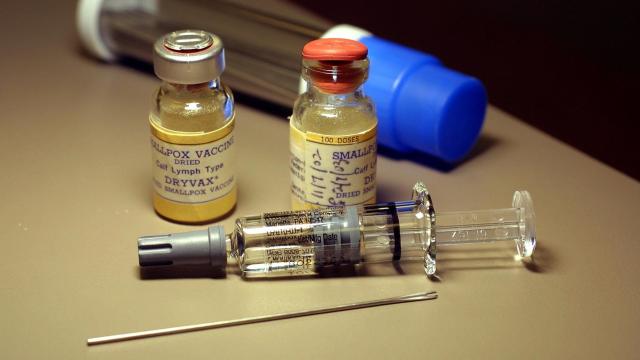Days after a Pennsylvania lab was locked down because a worker discovered vials labelled “smallpox” in a freezer, the CDC says there’s no reason to fear a viral outbreak. Late Thursday night, federal officials announced that the vials did not contain the deadly and eradicated variola virus. Instead, they held a related but much tamer virus, one that’s used to create smallpox vaccines.
Earlier this week, the Centres for Disease Control and Prevention revealed that a lab worker had uncovered the frozen vials as they were cleaning out a freezer at a Pennsylvania-based Merck vaccine research facility that works with the CDC. There were 15 vials in total, five of which were labelled “smallpox” and another 10 labelled “vaccinia,” the New York Times reports, citing a local official. The vials were then transferred elsewhere for testing on Wednesday. And it now turns out that the “smallpox” vials also contained the vaccinia virus.
“There is no evidence that the vials contain variola virus, the cause of smallpox,” the C.D.C. said in a statement sent Thursday to the New York Times.
Vaccinia is a virus with an intriguing backstory. Edward Jenner developed the first smallpox vaccines in the late 18th century, using what he believed to be cowpox, a cousin of smallpox that causes less serious illness in humans (smallpox killed 30% or more of its victims). However, whether the original inoculations actually contained cowpox isn’t clear, as the virus used in the vaccines that became the base of mass vaccination programs ended up being something called vaccinia, which closely resembles cowpox. The discrepancy wasn’t detected for a long time, and no one is sure whether vaccinia evolved from the first lab-cultivated cowpox strains, from another related virus called horsepox, or as a hybrid of several pox viruses. Its true origins are still a mystery, and vaccinia isn’t thought to exist in the wild. Once it was confirmed to be a truly distinct virus, vaccinia was named after the technology it was known for.
In any case, vaccination with vaccinia much less harmful than actually contracting smallpox, though the shot can often leave behind a characteristic skin scar at the injection site. The odds of that anyone was exposed to the contents of the freezer vials was low, the CDC said, since they were left intact upon discovery and the lab worker was reportedly wearing a face mask and gloves at the time.
A little over five years ago, lab workers with the National Institutes of Health did come across such a cache of smallpox samples, some of which contained viable virus. And though there are only two sanctioned sites in the U.S. and Russia where smallpox can be kept for study, scientists do suspect there are a few hidden stockpiles elsewhere. For now, though, there’s no immediate risk of a smallpox sequel.
